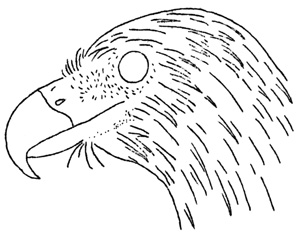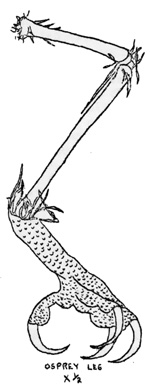

|
|
NATURE NOTES FROM ACADIA

On the ninth day of June Mr. O. Y. Thompson, expert woodsman and permanent ranger in Acadia National Park, guided me through the woods on Beech Hill to the eyrie of a bald eagle overlooking Long Pond. The nest which must have been several years old was saddled in the crown of a dead yellow birch about 35 or 40 feet from the ground. We were unable to view the contents of the big nest, but indications were that it was occupied by young birds. Ordinarily the eaglets on Mt. Desert Island do not leave their home before early July, and I therefore planned to return within the period of a few days since it was my desire to photograph the nestlings. That night the island was swept by a terrific windstorm which lashed the trees like some gigantic flail in the hands of the night wind. Large trees were uprooted or broken and limbs of all sizes littered the ground in wooded regions. Some of the venerable poplars which had been growing on the Village Green in Bar Harbor went down in the gale. The eyrie on Beech Hill had weathered many a storm, but this one proved too much for it. As the years had gone by the load borne by the weakening dead birch through additions made to the nest by the white-headed eagles had grown greater and greater. Like all such mighty structures, this one was doomed. But it was not until nine days after the fierce storm that I was able to return to the region of the big nest, and it was not until then that I discovered the tragedy. Upon my return to Beech Hill on the morning of June 18, accompanied by Mr. Vernon Lunt of Indian Point, I was quite amazed to find that the dead yellow birch which held the nest had crashed, broken off by the wind at a point about ten feet from the ground. My companion soon found the unfortunate feathered occupants - two eaglets drenched by the night's rain; one was dead, the other, its wing badly injured, stood humped up beside the lifeless nestmate only a few feet from the ruins of the nest. In all probability they had been on the ground for nine days and nights and to look at them was to look at a veritable scene of woe. So dense was the woodland in the immediate vicinity of the eyrie that the adult eagles in all probability had been unable to reach and feed their charges. They had not deserted the scene of the tragedy altogether, however, since we heard one of them when but a short distance from the fallen birch. Whether the impact of the fall accounted directly or indirectly for the death of one of the nestlings was impossible to determine. Examination of the body led me to believe that the bird may have succumbed to starvation, and this belief was strengthened upon failure to find remains of animal food of any kind near the body. What clues as to the food habits of this family of bald eagles did the nest contain? Eagerly my companion and I set about to pull apart the fallen structure. Remains of a crow, the wing of a black duck, the skulls and wings of five herring gulls, remains of several fishes including flounders and a sculpin, and a portion of the leg of a full-grown deer were found. Examination of the last-named item brought us to the conclusion that it had been severed from the animal by human hands, discarded, and later found by the hunting eagle and carried off to its nest. But what interested me most was the finding of three legs which I later identified as belonging to ospreys. It is common knowledge that the bald eagle robs the fish hawk of its prey, but here was evidence that the king of birds at times will rob this large hawk of its life. Perhaps these individuals refused to yield their finny prey - it must have been a grand spectacle this battle of the winged predators in the sky. 
What to do with the injured survivor of the crash? The bird, now perhaps two months of age, had been watching our examination of the big nest with apparent interest. Making no effort to leave the scene of this tragedy, he tolerated our stroking of his wet feathers with some reluctance. The bird had suffered a severe fracture at the bend of the right wing and a dislocation at the terminal portion of the same appendage. He was hungry, drenched, and cold, but in his dark eyes was that piercing sparkle which makes for a splendid dignity in our diurnal bird predators. To leave him in the woods was to leave him to die, either by starvation and exposure or by the teeth of some overbold hungry fox. But we did not deliberate long, and after having gathered together all the food remains which had been found in the nest, we left the ruins with an injured eaglet as our grand prize. For two days and nights the big bird was kept close to the stove in my house. Here he received a thorough and much-needed drying out and ate more or less heartily of fresh uncooked steak, fish, and eels, all of which were cut into small pieces before being offered to him. His condition on the second night of captivity became such that we feared the bird would not be found alive next morning, but to our pleasant surprise the health of our captive began to improve. He seemed to thrive on his diet of fish, raw beef, and fresh liver. A local veterinarian to whom the eaglet was brought for examination on the second day expressed considerable doubt regarding future possibility of flight. By the end of June my captive had grown considerably stronger. When hungry he whistles for food, and after his appetite has been satiated he twitters in an unmistakably satisfied sort of way. He has learned to drink, showing an early fondness for water. Occasionally he exercises his wings. My wife and I have become vary fond of our charge. We hope that the veterinarian was wrong and that some day the unfortunate eaglet will be able to soar on sturdy wings. - Ranger-Naturalist |
| <<< Previous | > Cover < | Next >>> |
nature_notes/acad/vol2-2b.htm
09-Jan-2006